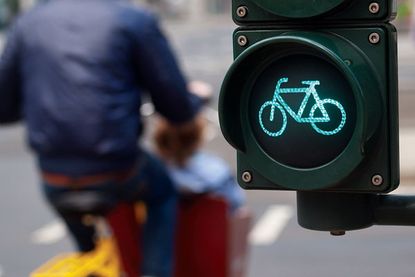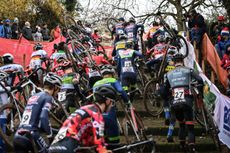Getting stopped by red lights could soon be a thing of the past thanks to this new technology
Dutch city installs technology to tell riders how fast they need to ride to make it through the next set of traffic lights

Especially at the end of a long, hard ride, there's nothing worse than having to stop at a red light, and then have to put in a load more effort to get back up to speed again once the lights turn green.
But thanks to some new technology being rolled out in the Netherlands (where else?), that unwanted extra effort could be a thing of the past.
>>> Dutch city installs traffic lights that give cyclists priority when it's raining
The new technology, which is called Flo, has been developed by Dutch technology company Springlab, and uses signals at the side of cycle paths to tell riders what speed they need to ride at so they don't have to stop at the upcoming traffic lights.
You get a thumbs up if you're travelling at the correct speed to make it through the traffic lights uninterrupted, a hare if you need to speed up, and a turtle if you need to slow down.
>>> New York cyclists battle $4,600 fine for running red lights
Of course, you're not always going to make it through the lights without putting your foot down, in which case you'll be shown a cow.
Get The Leadout Newsletter
The latest race content, interviews, features, reviews and expert buying guides, direct to your inbox!
The scheme is currently being trialled in the Netherlands, with residents of the city of Utrecht giving Flo rave reviews in the video above.

Thank you for reading 20 articles this month* Join now for unlimited access
Enjoy your first month for just £1 / $1 / €1
*Read 5 free articles per month without a subscription

Join now for unlimited access
Try first month for just £1 / $1 / €1
Henry Robertshaw began his time at Cycling Weekly working with the tech team, writing reviews, buying guides and appearing in videos advising on how to dress for the seasons. He later moved over to the news team, where his work focused on the professional peloton as well as legislation and provision for cycling. He's since moved his career in a new direction, with a role at the Department for Environment, Food and Rural Affairs.
-
 Trek USCX will host 4 consecutive UCI cyclocross race weekends on US soil
Trek USCX will host 4 consecutive UCI cyclocross race weekends on US soilTrek becomes American UCI Cyclocross series title sponsor, adding a fourth race to the series in October at its headquarters in Waterloo, Wisconsin.
By Kristin Jenny Published
-
 Lip service isn't good enough: here's what needs to change for cycling events to actually be inclusive
Lip service isn't good enough: here's what needs to change for cycling events to actually be inclusiveThese are the key actions that make an event actually inclusive and do more than just lip service.
By Marley Blonsky Published